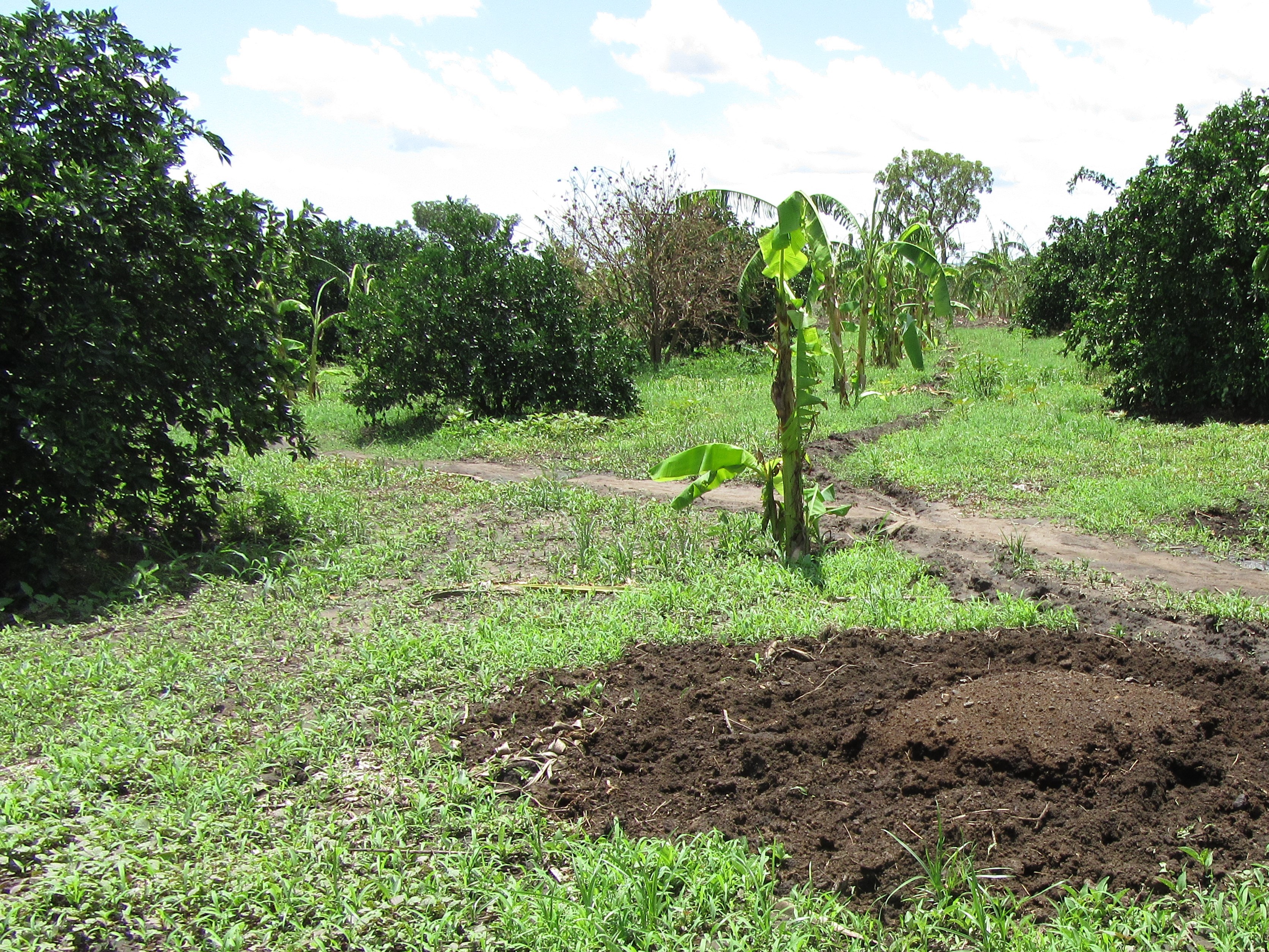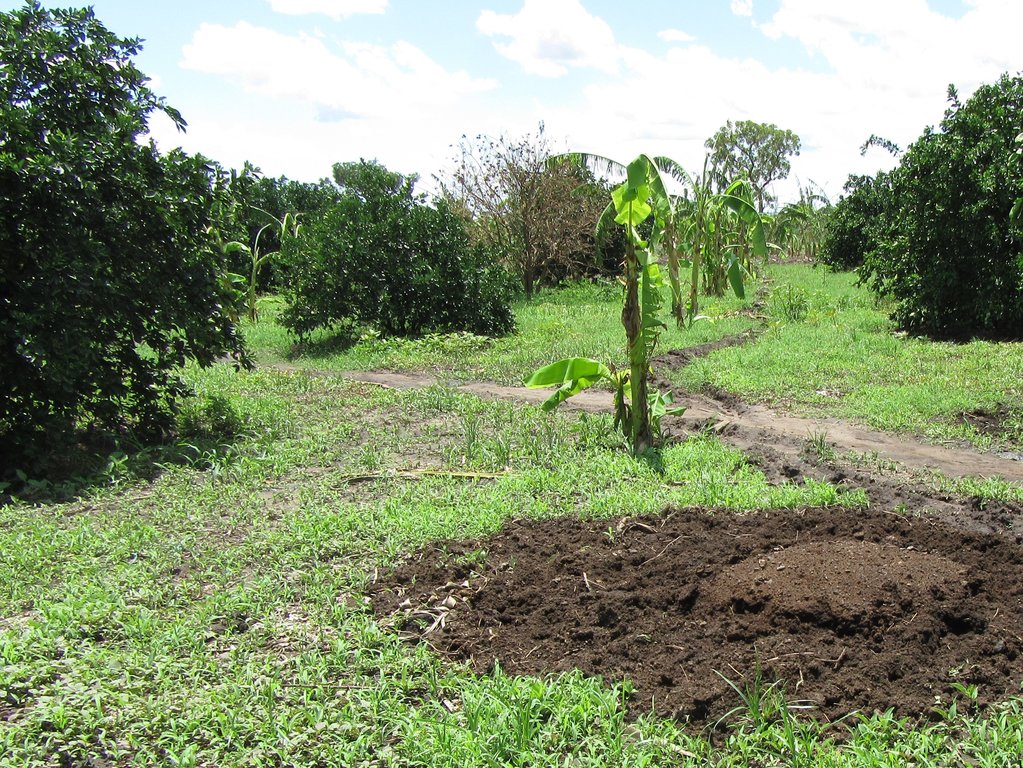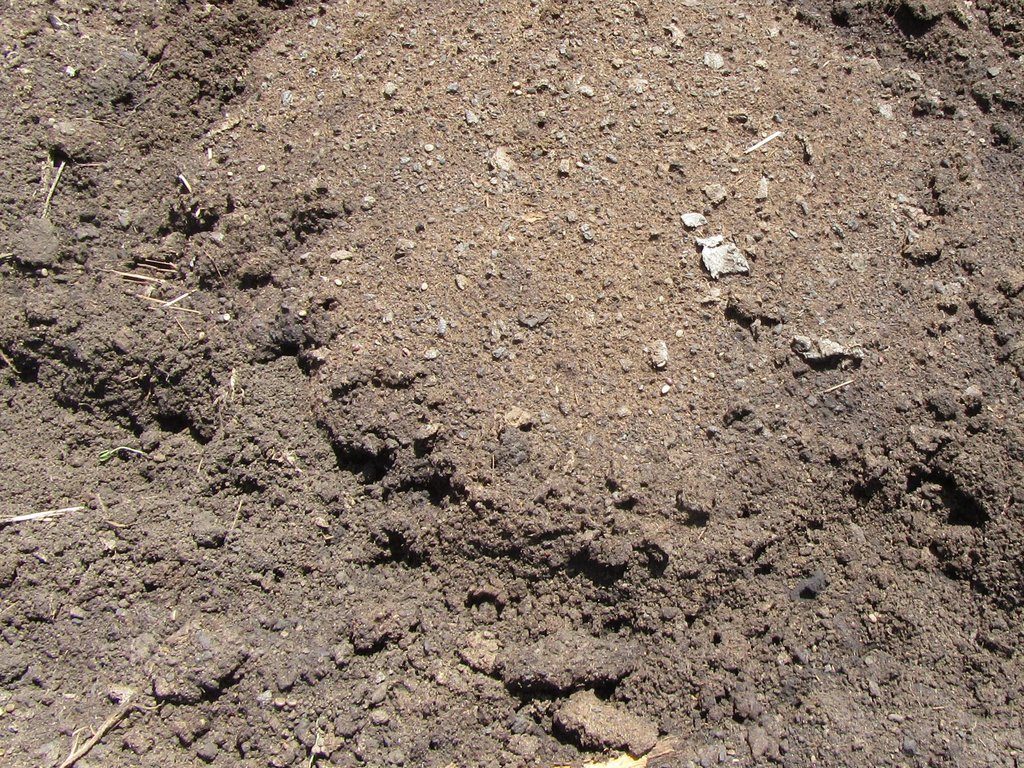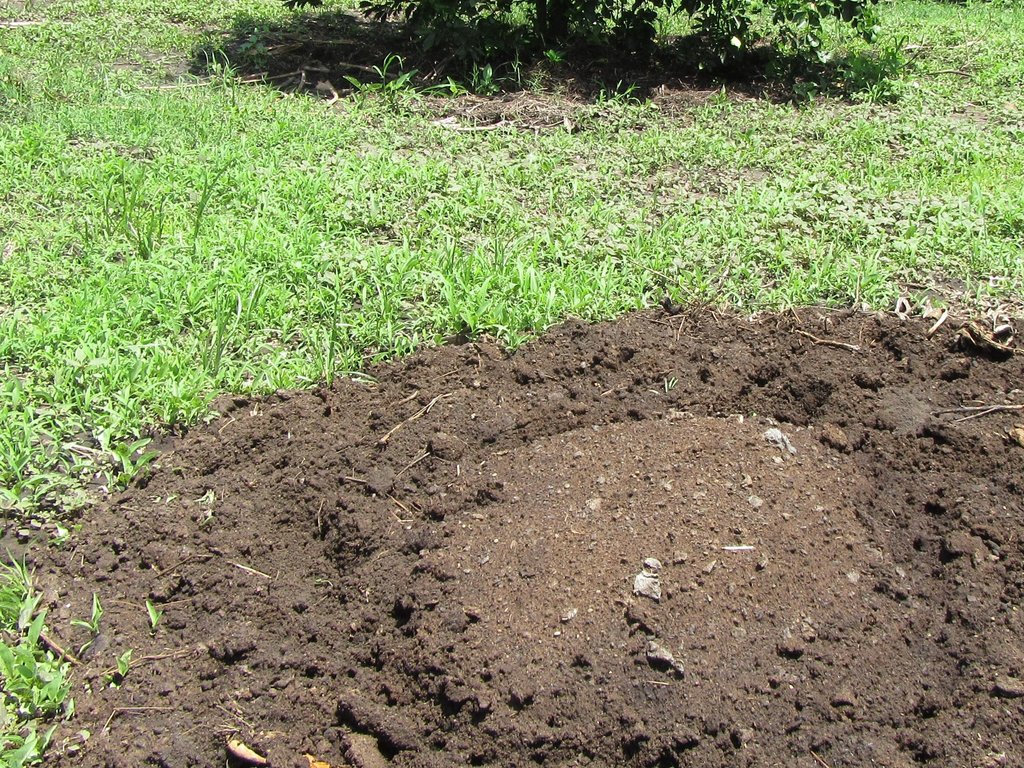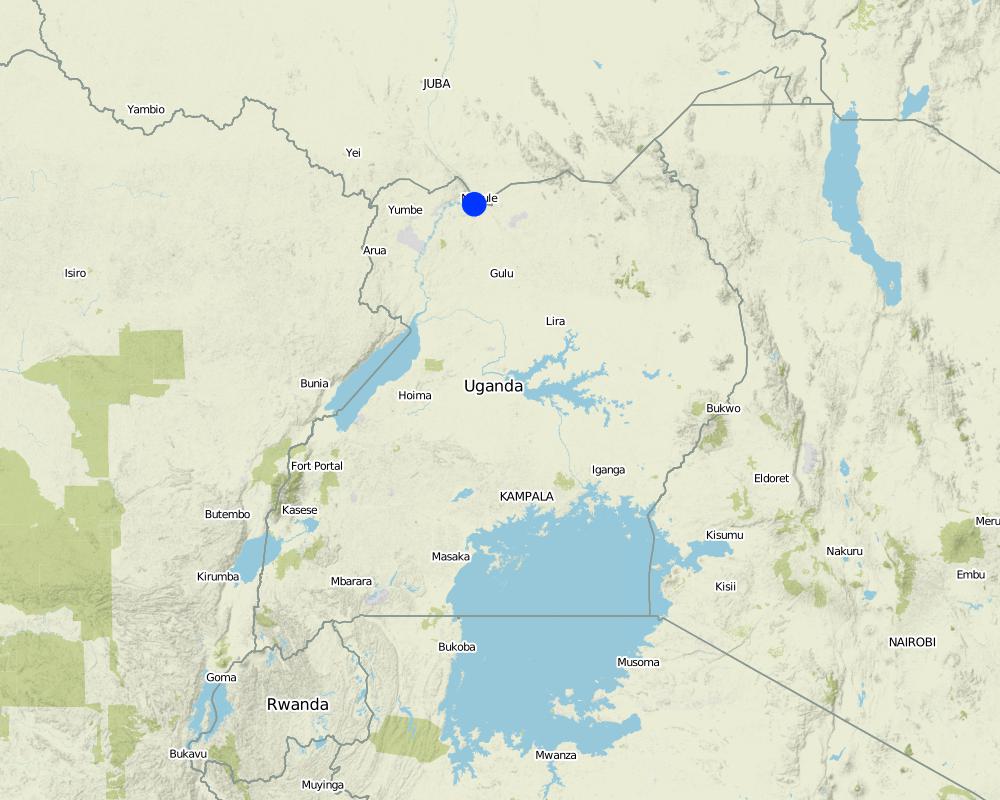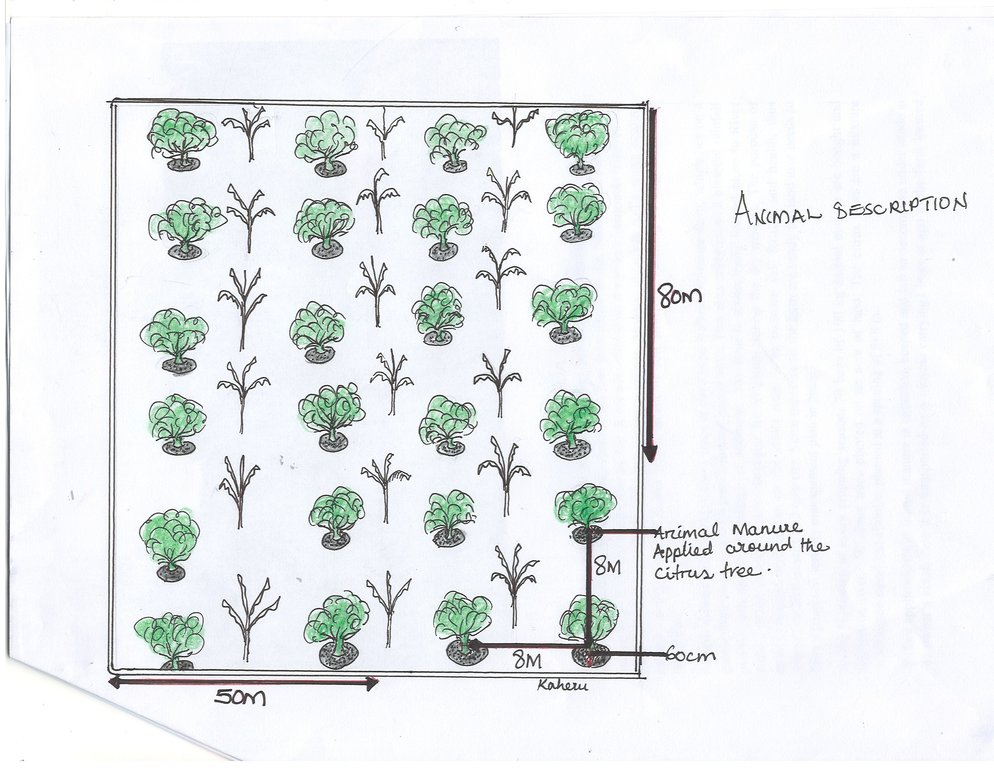Animal manure use in a citrus orchard [Uganda]
- Creation:
- Update:
- Compiler: Jalia Namakula
- Editor: JOY TUKAHIRWA
- Reviewers: Drake Mubiru, Nicole Harari, Alexandra Gavilano
Anyukwa
technologies_2254 - Uganda
View sections
Expand all Collapse all1. General information
1.2 Contact details of resource persons and institutions involved in the assessment and documentation of the Technology
Key resource person(s)
land user:
Ojoadi Charles
Green Valley enterprise
Uganda
Name of project which facilitated the documentation/ evaluation of the Technology (if relevant)
Scaling-up SLM practices by smallholder farmers (IFAD)Name of the institution(s) which facilitated the documentation/ evaluation of the Technology (if relevant)
Uganda Landcare Network (ULN) - Uganda1.3 Conditions regarding the use of data documented through WOCAT
The compiler and key resource person(s) accept the conditions regarding the use of data documented through WOCAT:
Ja
1.4 Declaration on sustainability of the described Technology
Is the Technology described here problematic with regard to land degradation, so that it cannot be declared a sustainable land management technology?
Nee
Comments:
Application of animal manure improves the soil organic matter content, hence improving soil fertility.
2. Description of the SLM Technology
2.1 Short description of the Technology
Definition of the Technology:
Application of animal manure on citrus trees (citrus sinensis) for improving soil productivity. Every beginning of season (March and August) 40 kg of animal manure are applied, 60 cm away from the tree trunk, using the ring method to improve soil fertility for increased yields and farm income.
2.2 Detailed description of the Technology
Description:
Use of animal manure is a recommended agronomic practice for soil fertility enhancement in agro-ecosystems. Animal manure application contributes to the build-up of soil organic matter and supplies most of the required nutrients, both of which ultimately improve soil health and productivity. Additionally, manure improves the soil’s water holding capacity, improves soil structure, resulting into improved water infiltration and reduced runoff.
Animal manure is applied on citrus trees at the Green Valley Enterprise farm located in Adjumani District found in Northern Uganda. The farm lies on a gentle slope in an area with predominantly sandy soils. This area experiences a bimodal rainfall pattern with an annual average of 1000 mm. The farm is strategically located close to River Adidi, which is used to provide water for irrigation during the dry months. The purpose of animal manure application on the citrus trees is to increase soil fertility and health, thus improving fruit quality and quantity. Since the soils on the farm are sandy, the land user needs to have a good soil fertility and water management plan in place.
At the beginning of every cropping season, 70 bags of animal manure from cows, each weighing about 100 kg are bought and applied on over 111 citrus trees planted on an acre of land. The citrus trees are a mixture of Washington navel and Hamlin, planted at a spacing of 6×6 m. Before application, the animal manure is collected, heaped and left to decompose under shade at the owner’s kraal for 4 months. At the farm, the manure is applied using the ring method, that is, 60 cm radius from the tree trunk and covered with grass mulch. Forty (40) kg of the manure is applied per tree per season. Application of the animal manure on one acre is estimated to cost UGX 540,000, while maintenance costs are estimated to be UGX 50,000 per season.
At this farm, animal manure application has increased citrus fruit yields up to seven folds. When covered with grass mulch it improves soil moisture retention, hence the farmer is able to have two major harvests annually. In addition, the trees on which manure is applied are more tolerant to dry spells. The main disadvantages of use of animal manure are intensive labour requirement for handling, and variability in manure quality depending on the source.
2.3 Photos of the Technology
2.4 Videos of the Technology
Comments, short description:
Video showing animal manure being applied on oranges.
Date:
10/05/2017
Location:
Elegu Central
Name of videographer:
Isa Yiga
2.5 Country/ region/ locations where the Technology has been applied and which are covered by this assessment
Country:
Uganda
Region/ State/ Province:
Northern Uganda
Further specification of location:
Elegu Central
Specify the spread of the Technology:
- applied at specific points/ concentrated on a small area
Comments:
3.52880,32.00569 is located in Adjumani District, Northern Uganda.
The manure is applied in this case around the citrus trees 60cm away from the tree trunk.
Map
×2.6 Date of implementation
If precise year is not known, indicate approximate date:
- 10-50 years ago
2.7 Introduction of the Technology
Specify how the Technology was introduced:
- through land users' innovation
Comments (type of project, etc.):
Land user started applying manure 10 years ago after realizing low yields without the use of any fertilizers on his crops.
3. Classification of the SLM Technology
3.1 Main purpose(s) of the Technology
- improve production
- reduce, prevent, restore land degradation
- create beneficial economic impact
3.2 Current land use type(s) where the Technology is applied

Cropland
- Perennial (non-woody) cropping
- Tree and shrub cropping
Perennial (non-woody) cropping - Specify crops:
- banana/plantain/abaca
Tree and shrub cropping - Specify crops:
- citrus
Number of growing seasons per year:
- 2
Specify:
Oranges are harvested in July and December
3.3 Has land use changed due to the implementation of the Technology?
Comments:
The land use has not changed since application of animal manure, the oranges were grown 10 years ago.
3.4 Water supply
Water supply for the land on which the Technology is applied:
- mixed rainfed-irrigated
Comments:
During the dry season, water is pumped from a stream that flows through the farm to irrigate the citrus trees .
3.5 SLM group to which the Technology belongs
- integrated soil fertility management
3.6 SLM measures comprising the Technology

agronomic measures
- A2: Organic matter/ soil fertility
3.7 Main types of land degradation addressed by the Technology

chemical soil deterioration
- Cn: fertility decline and reduced organic matter content (not caused by erosion)

biological degradation
- Bc: reduction of vegetation cover
- Bl: loss of soil life
Comments:
Application of animal manure enhances soil micro biomass
3.8 Prevention, reduction, or restoration of land degradation
Specify the goal of the Technology with regard to land degradation:
- prevent land degradation
- restore/ rehabilitate severely degraded land
4. Technical specifications, implementation activities, inputs, and costs
4.1 Technical drawing of the Technology
Technical specifications (related to technical drawing):
40 kg of animal manure are applied per citrus tree
citrus is planted at 8×8m
111 orange trees were planted, oranges planted are the Washington navel and Hamline type
The manure is applied using the ring method 60cm away from the tree trunk and covered with mulch
Author:
Prossy Kaheru
Date:
10/05/2017
4.2 General information regarding the calculation of inputs and costs
Specify how costs and inputs were calculated:
- per Technology area
Indicate size and area unit:
1 acre
If using a local area unit, indicate conversion factor to one hectare (e.g. 1 ha = 2.47 acres): 1 ha =:
0.40 ha
other/ national currency (specify):
Ug Shillings (UGX)
If relevant, indicate exchange rate from USD to local currency (e.g. 1 USD = 79.9 Brazilian Real): 1 USD =:
3650.0
Indicate average wage cost of hired labour per day:
6660
4.3 Establishment activities
| Activity | Timing (season) | |
|---|---|---|
| 1. | heaping of manure | Twice annually |
| 2. | transporting | Twice annually |
| 3. | loading and offloading | Twice annually |
| 4. | manure application | Twice annually |
Comments:
The animal manure is applied twice annually, application is done at the beginning of the season, that is in March and September.
4.4 Costs and inputs needed for establishment
| Specify input | Unit | Quantity | Costs per Unit | Total costs per input | % of costs borne by land users | |
|---|---|---|---|---|---|---|
| Labour | Heaping manure | heaps | 20.0 | 2000.0 | 40000.0 | 100.0 |
| Labour | Transporting | heaps | 20.0 | 5000.0 | 100000.0 | 100.0 |
| Labour | Application | acre | 1.0 | 50000.0 | 50000.0 | 100.0 |
| Fertilizers and biocides | animal manure | bags | 70.0 | 5000.0 | 350000.0 | 100.0 |
| Total costs for establishment of the Technology | 540000.0 | |||||
| Total costs for establishment of the Technology in USD | 147.95 | |||||
If land user bore less than 100% of costs, indicate who covered the remaining costs:
the land user bore all the costs
4.5 Maintenance/ recurrent activities
| Activity | Timing/ frequency | |
|---|---|---|
| 1. | collecting and heaping manure | Twice |
| 2. | transporting | Twice |
| 3. | application of manure | Twice |
4.6 Costs and inputs needed for maintenance/ recurrent activities (per year)
| Specify input | Unit | Quantity | Costs per Unit | Total costs per input | % of costs borne by land users | |
|---|---|---|---|---|---|---|
| Labour | collecting | heap | 10.0 | 5000.0 | 50000.0 | 100.0 |
| Labour | 1.0 | |||||
| Total costs for maintenance of the Technology | 50000.0 | |||||
| Total costs for maintenance of the Technology in USD | 13.7 | |||||
If land user bore less than 100% of costs, indicate who covered the remaining costs:
Costs are borne by land user
Comments:
When it comes to application of animal manure, most of the costs are borne by the land user.
4.7 Most important factors affecting the costs
Describe the most determinate factors affecting the costs:
Quantities of the manure
5. Natural and human environment
5.1 Climate
Annual rainfall
- < 250 mm
- 251-500 mm
- 501-750 mm
- 751-1,000 mm
- 1,001-1,500 mm
- 1,501-2,000 mm
- 2,001-3,000 mm
- 3,001-4,000 mm
- > 4,000 mm
Specify average annual rainfall (if known), in mm:
1217.00
Specifications/ comments on rainfall:
The rainfall on set have delayed for the last 2 seasons (2016, 2017) from March-April
Agro-climatic zone
- humid
5.2 Topography
Slopes on average:
- flat (0-2%)
- gentle (3-5%)
- moderate (6-10%)
- rolling (11-15%)
- hilly (16-30%)
- steep (31-60%)
- very steep (>60%)
Landforms:
- plateau/plains
- ridges
- mountain slopes
- hill slopes
- footslopes
- valley floors
Altitudinal zone:
- 0-100 m a.s.l.
- 101-500 m a.s.l.
- 501-1,000 m a.s.l.
- 1,001-1,500 m a.s.l.
- 1,501-2,000 m a.s.l.
- 2,001-2,500 m a.s.l.
- 2,501-3,000 m a.s.l.
- 3,001-4,000 m a.s.l.
- > 4,000 m a.s.l.
Indicate if the Technology is specifically applied in:
- not relevant
5.3 Soils
Soil depth on average:
- very shallow (0-20 cm)
- shallow (21-50 cm)
- moderately deep (51-80 cm)
- deep (81-120 cm)
- very deep (> 120 cm)
Soil texture (topsoil):
- medium (loamy, silty)
Soil texture (> 20 cm below surface):
- fine/ heavy (clay)
Topsoil organic matter:
- low (<1%)
If available, attach full soil description or specify the available information, e.g. soil type, soil PH/ acidity, Cation Exchange Capacity, nitrogen, salinity etc.
The soils according to the farmer are very poor.
5.4 Water availability and quality
Ground water table:
< 5 m
Availability of surface water:
excess
Water quality (untreated):
good drinking water
Is water salinity a problem?
Nee
Is flooding of the area occurring?
Ja
Regularity:
episodically
Comments and further specifications on water quality and quantity:
sometimes it rains and the stream fills up causing flooding but this doesn't happen every season
5.5 Biodiversity
Species diversity:
- medium
Habitat diversity:
- high
Comments and further specifications on biodiversity:
He is growing a number of crops on his farm (tomatoes, sugar cane, citrus and bananas), on the farm there is also a woodlot.
5.6 Characteristics of land users applying the Technology
Sedentary or nomadic:
- Sedentary
Market orientation of production system:
- mixed (subsistence/ commercial)
Off-farm income:
- 10-50% of all income
Relative level of wealth:
- rich
Individuals or groups:
- individual/ household
Level of mechanization:
- mechanized/ motorized
Gender:
- men
Age of land users:
- middle-aged
Indicate other relevant characteristics of the land users:
He is an ex soldier who retired into farming and he has a number of on-farm income generating activities.
5.7 Average area of land used by land users applying the Technology
- < 0.5 ha
- 0.5-1 ha
- 1-2 ha
- 2-5 ha
- 5-15 ha
- 15-50 ha
- 50-100 ha
- 100-500 ha
- 500-1,000 ha
- 1,000-10,000 ha
- > 10,000 ha
Is this considered small-, medium- or large-scale (referring to local context)?
- large-scale
Comments:
Average land holding of the people here is 2 ha. but he owns 5 ha of land.
5.8 Land ownership, land use rights, and water use rights
Land ownership:
- communal/ village
- customary
Land use rights:
- communal (organized)
Water use rights:
- communal (organized)
Comments:
This land tenure system land is owned communally
5.9 Access to services and infrastructure
health:
- poor
- moderate
- good
education:
- poor
- moderate
- good
technical assistance:
- poor
- moderate
- good
employment (e.g. off-farm):
- poor
- moderate
- good
markets:
- poor
- moderate
- good
energy:
- poor
- moderate
- good
roads and transport:
- poor
- moderate
- good
drinking water and sanitation:
- poor
- moderate
- good
financial services:
- poor
- moderate
- good
6. Impacts and concluding statements
6.1 On-site impacts the Technology has shown
Socio-economic impacts
Production
crop production
Quantity before SLM:
75 oranges per tree
Quantity after SLM:
200 oranges per tree
crop quality
Comments/ specify:
with application of animal manure fruit sizes have increased
Income and costs
farm income
Comments/ specify:
farm income has increased though no records are given
Socio-cultural impacts
food security/ self-sufficiency
Comments/ specify:
The oranges are consumed by the family therefore providing nutritional benefits to family.
Ecological impacts
Soil
soil moisture
Comments/ specify:
Using manure has increased soil organic matter, which in turn increases fertility and soil moisture retention,
Climate and disaster risk reduction
drought impacts
Comments/ specify:
Because it increases soil fertility and soil moisture retention animal manure helps the citrus trees to tolerate dry spells.
6.2 Off-site impacts the Technology has shown
Specify assessment of off-site impacts (measurements):
No off site impacts have been observed, however, continuous application of animal manure due to runoff can lead to eutrophication of streams
6.3 Exposure and sensitivity of the Technology to gradual climate change and climate-related extremes/ disasters (as perceived by land users)
Gradual climate change
Gradual climate change
| Season | increase or decrease | How does the Technology cope with it? | |
|---|---|---|---|
| annual temperature | increase | well | |
| annual rainfall | decrease | well |
Climate-related extremes (disasters)
Other climate-related extremes (disasters)
| other (specify) | How does the Technology cope with it? |
|---|---|
| Dry spells | well |
6.4 Cost-benefit analysis
How do the benefits compare with the establishment costs (from land users’ perspective)?
Short-term returns:
positive
Long-term returns:
very positive
How do the benefits compare with the maintenance/ recurrent costs (from land users' perspective)?
Short-term returns:
positive
Long-term returns:
very positive
Comments:
The land user attests that benefits surpass both establishment and maintenance costs
6.5 Adoption of the Technology
- single cases/ experimental
6.6 Adaptation
Has the Technology been modified recently to adapt to changing conditions?
Nee
6.7 Strengths/ advantages/ opportunities of the Technology
| Strengths/ advantages/ opportunities in the land user’s view |
|---|
| Animal manure increases the quantity and quality of the citrus |
| It increases the water holding capacity |
| It improves soil fertility |
| Strengths/ advantages/ opportunities in the compiler’s or other key resource person’s view |
|---|
| It is improves agro-ecosystem functioning |
| increases farm income |
| improves food security of family |
6.8 Weaknesses/ disadvantages/ risks of the Technology and ways of overcoming them
| Weaknesses/ disadvantages/ risks in the land user’s view | How can they be overcome? |
|---|---|
| If not proper covered with soil or mulch, nutrients can easily be eroded | cover it properly or apply beneath the soil |
| manure is not readily accessible | outsource from different farmers |
| Weaknesses/ disadvantages/ risks in the compiler’s or other key resource person’s view | How can they be overcome? |
|---|---|
| it is slow in action hence easily affected by weather | it is applied on perennial crops |
| May contain excess salts |
7. References and links
7.1 Methods/ sources of information
- field visits, field surveys
one informant
- interviews with land users
one informant
When were the data compiled (in the field)?
10/05/2017
Links and modules
Expand all Collapse allLinks
No links
Modules
No modules


